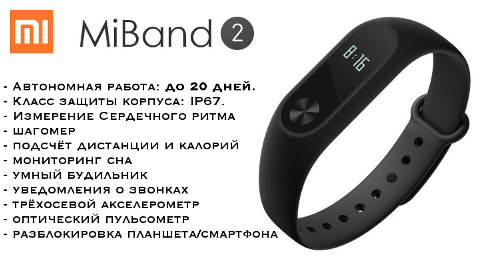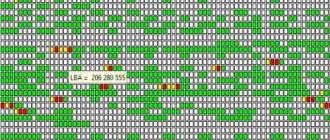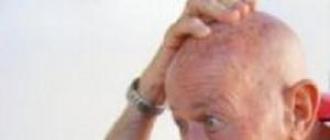To date, a cell phone has become an important part of our lives. With the help of it we correspond, call up and use mobile internet. But even now, when operators cellular communication do everything to improve communication, there are failures, and sometimes communication disappears or is completely absent. Not everyone knows how cellular communication works and on what its quality depends. To cover the territory and the high quality of cellular communication, the operator companies are increasingly building (installing) base stations. Map base stations help you stay in touch. Each operator has a wide network of 3G base stations (third generation) and 4G LTE (fourth generation). If you have not yet decided on the operator's choice or you want to switch to another, you may be interested in a map of the base stations of the mobile operator you need, which will show the coverage area in detail. The range of one station depends on the position of the position and the frequency range. 3G stations in megacities reach - 500 m, in open areas - up to 35 km. Stations 4G LTE - the radius can be different, optimally - it's about 5 km, but if necessary it can be up to 30 km or even 100 km (with sufficient antenna lifting).
Operators mobile communication have learned to combine low and high frequencies. For a locality with a small number of subscribers, while they occupy a large area, networks that work in low bands are ideal. And in large and densely populated cities networks are built in high ranges. Behind dual-band LTE networks, and the future of mobile communications is worthwhile.
View the map and find out the coordinates of the base stations of cellular operators, as well as understand the coverage areas of mobile operators depending on the region can be on different sites. Examples of such sites are the following resources:
- http://bsmaps.ru/maps.php - coverage areas of Megafon, MTS, Tele2 in the central federal district;
- http://tolyatti.beeline.ru/customers/beeline-on-map/ - Beeline coverage areas
- http://www.mts.ru/mobil_inet_and_tv/help/mts/coverage/ - MTS coverage area
The quality of mobile communications from the operator companies is different. On the site of the State Service launched a national project - "Quality of Communication" (creating a quality map of cellular communications using the mobile application "Quality of Communication"). https://www.gosuslugi.ru/555666/1/
On the project "Angry Citizen" you can complain about poor communication quality.
If the coverage is unsatisfactory, and there are uncovered areas ("white spots"), then the connection is unstable and may be interrupted. Our resource is created to solve these problems.
Here you can see the layout of the base stations on the interactive
How to choose the right set for the Internet.
In order to choose the optimal set for reliable operation of the Internet, you need to know the answers to several questions.
- Where and at what distance is the nearest base station on which there is Internet?
- Is there any direct visibility to the base station from the place where the antenna is supposed to be installed?
- What is the length of the RF cable to reduce the antenna required to connect?
There are two options for answering the first question.
First option:
The easiest way is to use the coverage cards that cellular operators publish on their websites.
Below is a list of links to the coverage cards of the major cellular operators.
Let's set ourselves the task of determining the possibility of 3G Internet access in Nagyshi village of the Ryazan Region. On the map of the MTS operator's coverage, we determine that the nearest base station is located in Gorlovo, Ryazan Region.
We find the more or less precise location of the base station. As a rule, the antenna pattern of the base station antenna is similar to a trefoil, because three sectoral antennas with a 120 ° radiation pattern are applied on the base, and the base will be in the center of this figure.
Next, using the Yandex map, we find the distances between the client and the base station. This is necessary not to do unnecessary work unnecessarily, if the distance is more than 30 km, it is likely to establish a connection over 3G is likely not to work
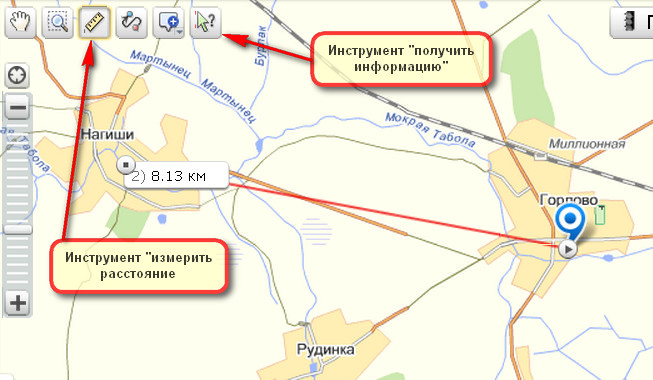

Using the "Get information" tool, we determine the coordinates of the 3G base station and the location of the proposed antenna installation.
We have obtained such coordinates:
Base 53 ° 49'37.35 "N 39 ° 2'30.3" E
Customer 53 ° 50'20.41 "N 38 ° 55'7.82" E
The first service is very simple and straightforward, you just need to enter the coordinates of the database and the client specify the height from the ground surface for the base it is usually from 50 to 120m, for the client 10-15m.
There is one limitation this service on will be able to build a route if the coordinates of the place will be more than 60 ° SS or 60 ° Yu.S.T.e. to calculate the route in the vicinity of Arkhangelsk no longer work.
That's what happened in our case.
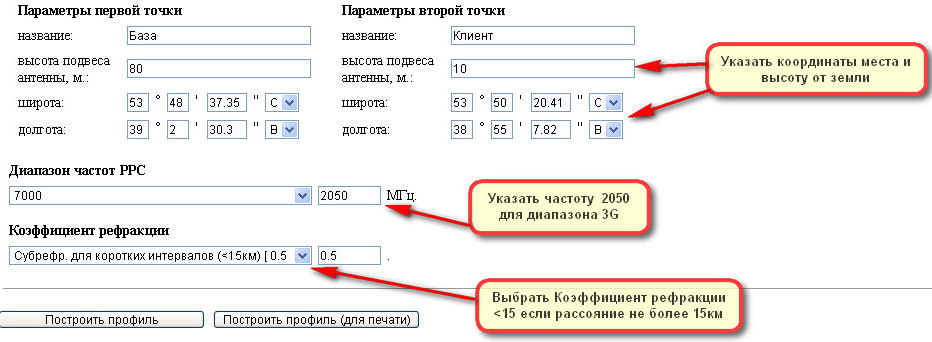

According to the schedule of the route it can be seen that there is nothing to get a sure reception in the place where the antenna is installed, even if the base height is less (50 m), there will still be a direct visibility between the antennas.
When you go to the resource immediately go to the tab Tower

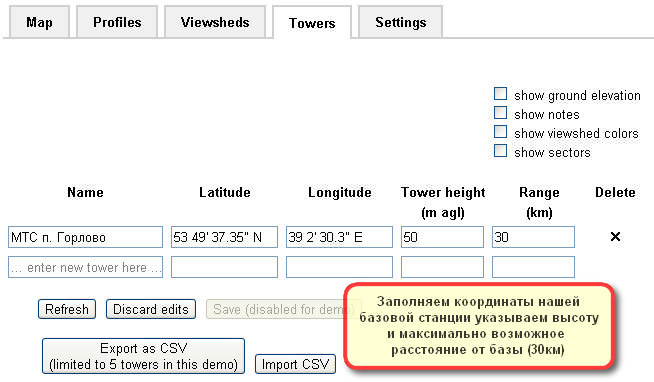
Delete the lists of base stations by clicking on the "cross" to the right of the table and fill in the data of our database for saving, click on the Refresh
Go to the tab Map
we reduce the size of the map and transfer the "cross" to the location of the receiving antenna, guided by the names on the map and the coordinates at the bottom of the map.


Clicking the tab Profiles you can see the profile of the route. As you can see, and the right picture of the route is open and will be able to ensure a confident reception of 3G.
scroll down the page to the heading "System Performance"
We will proceed from the fact that to get the signal level on the receiving side not less than -85dBm, and the gain margin for "bad weather" is not less than 10dB.

Fill in the free fields based on the fact that the receiving antenna has a gain of 14 dB, transmitting 12 dB, the transmitter power of the base is 3 watt, the loss in the drop cable of the base is 2 dB, in the cable for reducing the receiving antenna is 5 dB. Click calculate and get the result above. Based on the calculated data, it turns out that the margin for amplification is 24 dB, that is, it will work in any weather. The signal level on the receiving side will be about -64 dB, which will allow us to have a steady steady reception of the Internet with the highest possible speed.
The second option:
In order to find out the location of the base station, it is necessary to take a phone with 3G support (now this is not uncommon), and guided by the indication of the signal level indicator on the phone, move towards the amplification of the signal until you see a structure similar to the one shown below:


Noting the location of the station using the maps http://maps.yandex.ru determine the distance to the installation site and coordinates.
The antenna should be installed in an open space, as high as possible from the ground surface and oriented towards the source of the signal. To fix the antenna is better on a separate, earthed mast or the wall of the house facing the base station. The antenna in the direction of the base station should not be blocked by vegetation and high objects, even at a considerable distance and within a radius of about 8 meters from the axis of the route-it will greatly weaken the possibility of 3G Internet access. Remember that the antenna requires direct visibility to the base station! Also, you should not install the antenna under the roof of the house, even from non-metallic parts (slate, rubber, roofing material, etc.). Also, do not install an antenna near the chimney, excessive uneven heating will disable the antenna.
Detecting communication towers is not a criminal activity, but rather a common task in remote regions and villages, where the quality of the coating leaves much to be desired. How to understand why this pillar takes better than from that gate? The following tools and websites can help you find your way.
Of English-speaking services, perhaps, best opensignal.com, where you can choose the operator and the necessary location. The map does not display the tower, but shows the coverage areas. From the Russian I can recommend netmonitor.ru - in its database contains a lot of information about the towers of operators.
Interesting and some applications for Android. For example, OpenSignal displays a map cellular towers and wi-Fi hotspots (even on the map are marked the places with poor communication), has a built-in compass and speed verification tool.
Another interesting tool is Netmonitor. It is able to monitor GSM and CDMA networks, shows information about the signal level, contains a database of cellular towers, supports devices with several SIM cards, and also manages to log in the CLF or KLM format.

Pay attention, Netmonitor has limitations when working on devices of some manufacturers. On smartphones Motorola, LG, Samsung, Acer and Huawei, the list of neighbors can be empty, and on Samsung devices, the signal level may not be displayed.
I will also recommend the GSM Signal Monitoring application, which allows you to work with GSM, UMTS and LTE networks. It shows the signal level change on the graph and shows adjacent cells (only in GSM networks). There is a data rate monitor and the ability to monitor the status of the connection, the connection standard, the cell and current zone identifiers (LAC / RNC / TAC), and the received signal strength level (RSSI, as well as RSRP for LTE).

Knowing the data of the base station, you can punch it through the site xinit.ru and get information about its location. In large cities, you can try to find national maps with the location of towers, but it is worth noting that the towers belong to different operators. Plus, the base stations are put not only on poles, but also on the roofs of houses.
